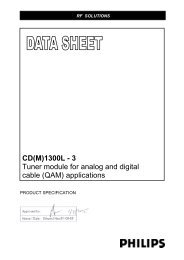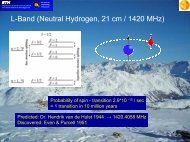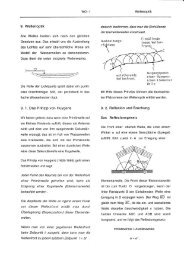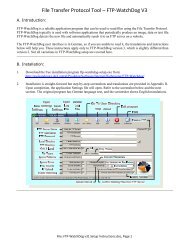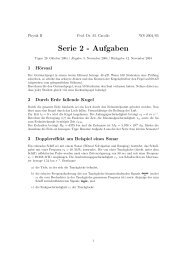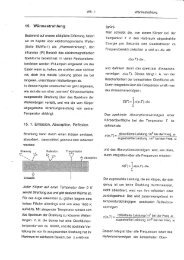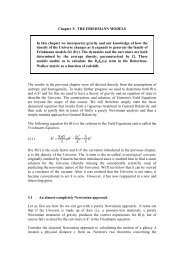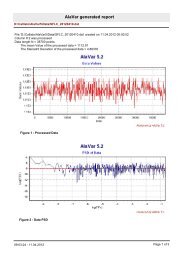here - Institute for Astronomy Umleitung
here - Institute for Astronomy Umleitung
here - Institute for Astronomy Umleitung
You also want an ePaper? Increase the reach of your titles
YUMPU automatically turns print PDFs into web optimized ePapers that Google loves.
Title: Science Case<br />
Reference: MUSE-MEM-SCI-052<br />
Issue: 1.3<br />
Date: 04/02/2004<br />
Page: 50/100<br />
2.14. A pan-chromatic view of galaxy <strong>for</strong>mation<br />
In this section we describe complementary surveys that should be carried out within the same<br />
volume of space as the MUSE deep fields in order to extract the maximum possible science<br />
from the data. We show that by observing <strong>for</strong> comparable time periods with ALMA, e-VLA,<br />
JWST, and possibly SKA, one can map out the neutral and molecular gas content of the<br />
volume to compare with the ionized gas seen in the MUSE and JWST data, and the starlight<br />
imaging in<strong>for</strong>mation from JWST.<br />
2.14.1. JWST<br />
Thanks to its unrivalled sensitivity in the thermal infrared JWST is designed to be a major<br />
player in the understanding of <strong>for</strong>mation and evolution of galaxies. JWST has a wide spectral<br />
range (0.6-28 µm), but it is only above 1 µm, and probably even above 2 µm, that it shows its<br />
strength with respect to ground based telescopes of similar or larger aperture. Among the 3<br />
instruments, the ESA NIRSPEC spectrograph is particularly well suited to distant galaxy<br />
study because of its multiplex capabilities in the 1-5 µm wavelength range. NIRSPEC is able<br />
to observe simultaneously a maximum of 100 objects in a 3x3 arcmin², at two spectral<br />
resolutions 6 of 100 and 1000. The 2.9-5 µm grating of the R~1000 mode is of special interest<br />
given its almost perfect match in H α redshift range (3.5-6.7) with MUSE Ly α coverage (2.8-<br />
6.7). According to simulations (section 2.2) a MUSE deep field should give 150-200 Ly α<br />
emitters in that redshift range. Depending on the source clustering, in two to four exposures of<br />
15 hours each, NIRSPEC would be able to detect the H α line of all MUSE high z objects 7<br />
with a comparable S/N. Having access to Ly α and H α would not only confirm unambiguously<br />
the redshift of the source, but will give access to dust extinction and star <strong>for</strong>mation rate<br />
measurements. Comparison of line profiles would also tell us about resonant scattering and<br />
velocity shifts of Ly α . Moreover this pre-selection of sources by MUSE should be at least as<br />
efficient as multi-band deep imaging with NIRCAM. The combination of VLT/MUSE and<br />
JWST/NIRSPEC is quite attractive and should strengthen the JWST European scientific<br />
return.<br />
2.14.2. ALMA<br />
The Atacama Large Millimetre Array (ALMA) will provide the principal means of measuring<br />
the rest-frame FIR emission of galaxies as an observed submm/mm continuum, and their<br />
molecular gas content via the CO lines.<br />
With its 64 antennas (each of 12 m diameter), its 16 GHz bandwidth and its first four<br />
receivers covering the 86–116, 211–275, 275–370, and 602–720 GHz bands (be<strong>for</strong>e<br />
completion to a final figure with 10 bands), ALMA will reach at least 100 µJy (5 σ) in an<br />
6 NIRSPEC has another mode with a higher spectral resolution (R~3000) but without multiplex capabilities (only<br />
one single long slit).<br />
7 For the 3.9 10 -19 erg.s -1 .cm -2 MUSE detection limit is able to detect a Ly α line of 2.7 10 -18 erg.s -1 .cm -2 with 85%<br />
obscuration. This translates into 3.1 10 -19 erg.s -1 .cm -2 H α flux, assuming a flux ratio of 8.7 between the two lines.




